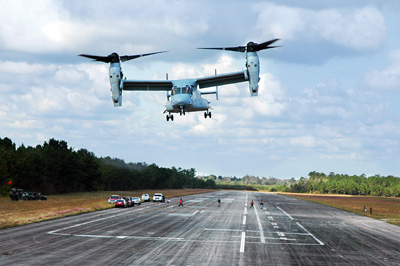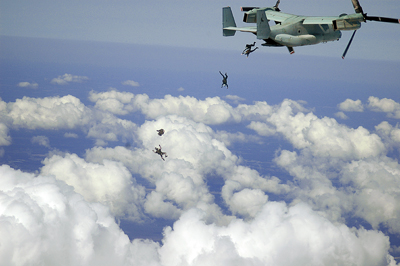By Staff Sgt. C. Todd Lopez
MARINE CORPS AIR STATION NEW RIVER, N.C. (Oct. 12, 2004) -- The Air Force's top two leaders got up close and personal Oct. 8 with what may become the service's latest special operations asset.
Secretary of the Air Force Dr. James G. Roche and Air Force Chief of Staff Gen. John P. Jumper flew in a Marine Corps MV-22 Osprey. General Jumper served as pilot of one craft, and Secretary Roche as a passenger in another. Air Force officials plan to purchase as many as 50 CV-22s, a variation of the Marine Corps MV-22.

Secretary Roche said the service already has plans for the aircraft within the special operation community. Officials are looking for applications in search and rescue operations and open to potential applications elsewhere.
"This plane can do things we never could do before, like give advantages to our Air Force special operations folks for infiltration or exfiltration," Secretary Roche said. "We are also going to take a look at this plane as a long-range combat search and rescue asset."
The secretary said the performance of the aircraft -- its speed and relative quietness compared to a helicopter -- opens up all kinds of possibilities for potential application in the Air Force.
"We see new concepts of operations because we can have our folks get in very close without tipping off (the enemy) with the noise -- you don't have the advance sound you get from a regular helicopter," Secretary Roche said. "It leads you to think of things you can do that might have been difficult in the past."
The V-22 is a "tilt-rotor" aircraft designed by Boeing with partner Bell Helicopter Textron. When turned toward the sky the two wing-mounted rotors on the craft allow for a vertical takeoff like a helicopter. When turned forward, the craft flies as an airplane. The aircraft is capable of switching between the modes at any time.
Army Gen. Bryan D. Brown, commander of U.S. Special Operations Command, also flew aboard one of the craft, though he did not land with the plane. Instead, the general jumped out of the back with a team of special operations parachutists.
"It was a great jump," General Brown said. "This is the first time I have been in the V-22, and it is a very impressive aircraft with great performance. It will be valuable in the special operations community. We look forward to getting it."

General Brown said the speed of the V-22, compared to that of a traditional helicopter, is a primary benefit of the craft.
"I flew helicopters in Vietnam, and we flew at 90 knots," he said. “I flew helicopters in [Operation] Desert Storm, and we flew at 120 knots. In over 20 years, we gained only 30 knots. (The V-22) changed that dramatically. We were cruising around today at over 240 knots. That gives us a lot of range and reduces our requirements for logistics and for tankers."
The general also said he felt it was important for him to get firsthand experience with the airplane so he could let those in his command know how important the aircraft will be to the special operations community.
"It's important I was able to get out and see this for myself, to fly in it and to have it demonstrated to me," the general said. "I'll be able to go back and tell our folks just exactly how well the program is going, how well the testing is going and what great performance we get out of the aircraft. I hope this says that we think this is an important piece of equipment for the future of special operations."
The V-22 Osprey program is a joint venture between the Marine Corps and the Air Force. Secretary Roche told a contingent of Marines gathered here that he was pleased with the work they have done to move the V-22 program forward. He also said he was impressed with the joint effort between Marines and Airmen.
"What you have done in the last two years is really noteworthy," Secretary Roche said. "You have taken a program people thought was a dead duck and turned it into something that is causing us to think of new (concepts of operations. This) is a Marine Corps aircraft, under the Department of the Navy, with a program manager who is an Air Force officer and crews that are mixed between Air Force and Marines -- on behalf of a lot of us in the Air Force, our compliments to this Air Force and Marines team."
The CV-22 will replace the MH-53J Pave Low helicopter and augment the MC-130 fleet in special operations missions. The purchase date of the 50 CV-22 has not been determined.